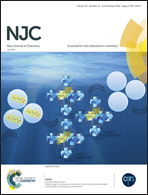A highly sensitive fluorescent probe for selective detection of cysteine/homocysteine from glutathione and its application in living cells and tissues†
Abstract
Biothiols such as cysteine (Cys), homocysteine (Hcy) and glutathione (GSH) play significant roles in maintaining biological homeostasis in organisms. Due to their particular significance in the physiology and pathology of humans, accurate determination and differentiation of Cys, Hcy, and GSH for understanding their roles in related diseases are in urgent demand. Herein, a new fluorescent probe NIPY-NBD was designed and synthesized for the detection of Cys/Hcy and GSH. The probe exhibits a variety of excellent properties including high sensitivity and low cytotoxicity as well as good cell membrane permeability. Furthermore, the probe showed a 100-fold (λex/em = 310 nm/520 nm) and 210-fold (λex/em = 340 nm/550 nm) fluorescence enhancement when reacted with Cys in buffer, and could swiftly respond to Cys and Hcy within 2.5 min. NIPY-NBD was further applied successfully in imaging in A549 cells and xenograft mouse tumor tissues. Taken together, NIPY-NBD may have great potential in detecting and distinguishing Cys/GSH in living animals and could be applied in tumor diagnosis.



 Please wait while we load your content...
Please wait while we load your content...